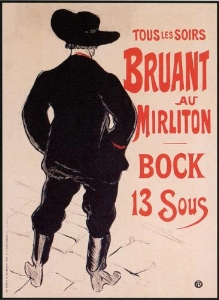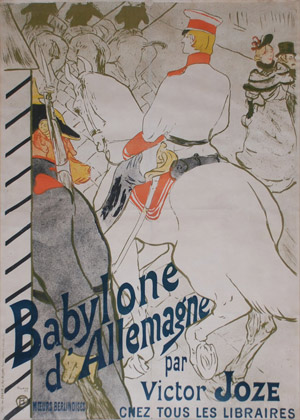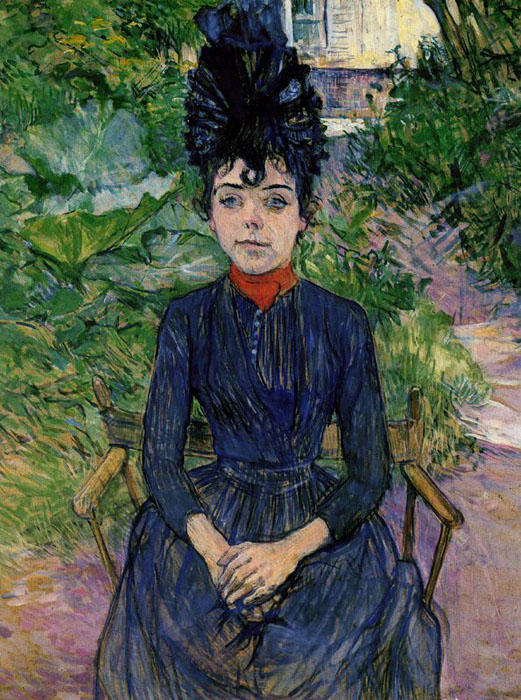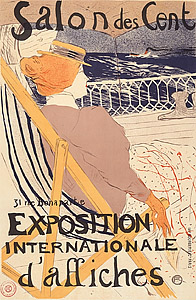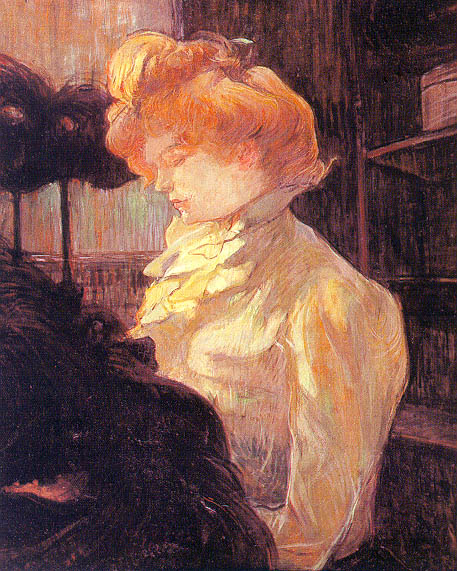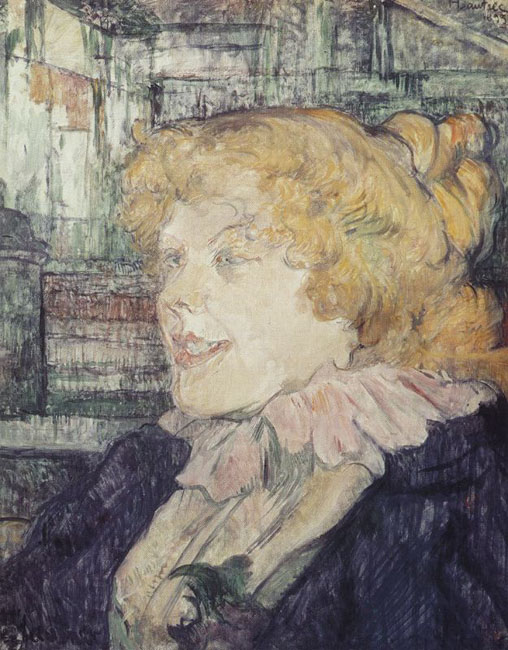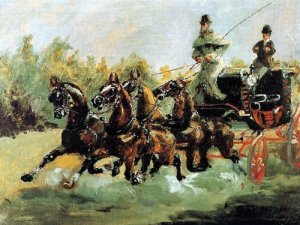Toulouse Lautrec is included among the impressionists. His work is famous for it's cabaret scenes. We include him in this series of the impressionists. But have not attempted to display all of his subject matter.

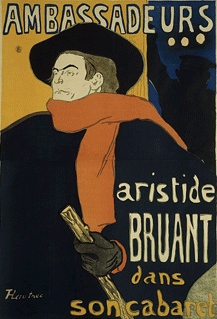 The French painter, printmaker, draftsman, and illustrator, Henri Marie Raymond de Toulouse-Lautrec-Monfa was born in Albi, Tarn in the Midi-Pyrénées région of France. He was the firstborn child of Comte Alphonse and Comtesse Adèle de Toulouse-Lautrec. He was born into one of the oldest of aristocratic families (descendants of the Counts of Toulouse and Lautrec and the Viscounts of Montfa, a village and commune of the Tarn department of southern France). The House of Toulouse could trace its origins as far back as the 770s; the family grew in power and importance over the centuries, leading Crusades, marrying into various royal families, and for a time ruling their territory in southern France. His mother and father were cousins. Henri suffered from a number of congenital health conditions attributed to this tradition of inbreeding, that is thought to have been a reason for his weakness and bad health. A younger brother was also born to the family on 28 August 1867, and named Richard Constantine, but he died the following year, when he was one year of age. After the death of his brother his parents separated and a nanny took care of Henri through this time.
The French painter, printmaker, draftsman, and illustrator, Henri Marie Raymond de Toulouse-Lautrec-Monfa was born in Albi, Tarn in the Midi-Pyrénées région of France. He was the firstborn child of Comte Alphonse and Comtesse Adèle de Toulouse-Lautrec. He was born into one of the oldest of aristocratic families (descendants of the Counts of Toulouse and Lautrec and the Viscounts of Montfa, a village and commune of the Tarn department of southern France). The House of Toulouse could trace its origins as far back as the 770s; the family grew in power and importance over the centuries, leading Crusades, marrying into various royal families, and for a time ruling their territory in southern France. His mother and father were cousins. Henri suffered from a number of congenital health conditions attributed to this tradition of inbreeding, that is thought to have been a reason for his weakness and bad health. A younger brother was also born to the family on 28 August 1867, and named Richard Constantine, but he died the following year, when he was one year of age. After the death of his brother his parents separated and a nanny took care of Henri through this time.
His father, Count Alphonse, was a notorious eccentric known for all kinds of unpredictable behavior. Contrary to acceptable bahaviour for a count, he'd wash his socks in the river (unheard of for an aristocrat!) or gallope off to a hunt wearing unusual costumes.
Henri spent most of his young life confined to bed. He was not able to keep up with his father and the other men in their hunting adventures. In 1872 the countess moves to Paris with eight year-old Henri. Lautrec's parents were both amateur artists who encouraged his early talent at drawing. By the time he was 10 he had begun to draw and paint. At 12 he broke his left thighbone by simply standing up from the sofa. In August of 1879 Henri broke his right thighbone while walking with his mother in Barèges.
Since the young Henri was now disabled and unable to live a normal life, his mother encouraged him to paint. The breaks did not heal properly (modern physicians attribute this to an unknown genetic disorder along the lines of osteoporosis or osteogenesis imperfecta; sometimes known as Toulouse-Lautrec Syndrome) others speak of rickets aggravated with praecox virilism), and his legs ceased to grow, so that as an adult he was only 1.52 m/5 ft tall, having developed an adult-sized torso while retaining his child-sized legs. As an adult, he stood 4 feet 11 and walked with painful difficulty.
Because Latrec's dwarfism was due to insufficient genetic variety, he was incapable of retaining nutrients, including calcium, to strengthen bones, promote growth, and prevent fracture. By the time Lautrec was sixteen years old, he was permanently dwarfed, he walked with a kind of ducklike stagger and had an embarrassing drool.
In 1882, accompanied by his mother, Toulouse-Lautrec left the family estate and moved to Paris to study at the prestigious Ecole des Beaux-Arts and the studio of Fernand Cormon, where he met Vincent van Gogh. He painted Van Gogh's portrait. Toulouse-Lautrec sketched everywhere he went, faithfully capturing on paper what he saw – the colorful characters, the dancers and singers, comedians and circus performers. In 1884 Toulouse-Lautrec settled in Montmartre, where he stayed from then on, except for short visits to Spain, where he admired the works of El Greco and Diego Velázquez, and Belgium. Toulouse Lautrec exhibited his first works in the cafes and restaurants of Montmartre. His paintings soon attracted general attention and he received his first commissions. He frequented Impressionist circles and particularly admired Degas.
THE JAPONISME INFLUENCE
With the treaty of Kanagawa in 1854 between the American delegation headed by Navy commander Matthew Calbraith Perry (1794-1858) and the Japanese shogunate government, a period of 216 years of Japanese isolation ended.
From the 1850s onwards, objects from Japan flowed into the west and attracted the attention of both artists and collectors. The Paris Exposition Universelle of 1867 brought an influx of more things Japanese, as well as Japanese visitors to the city. The term "japonisme" was coined in 1872 by Philippe Burty, a French art critic, to describe what was essentially a new field of study - the influence of Japanese style on French art.
Toulouse Lautrec, like no other nineteenth century artist was deeply influenced by Japanese woodblock prints. His artwork definately demonstrates the influence of Degas as well as that of Japanese prints.
PAINTING & PRINTING STYLE & TECHNIQUES

 Lautrec sketched constantly, often in a series of tiny notebooks sometimes even on napkins and tablecloths. At least one drawing still exists which was done with a burnt match. He started as a painter but in 1891 he was introduced to the art of printmaking.
Lautrec sketched constantly, often in a series of tiny notebooks sometimes even on napkins and tablecloths. At least one drawing still exists which was done with a burnt match. He started as a painter but in 1891 he was introduced to the art of printmaking.
The artist created his first lithograph in 1891. Lautrec used a wide range of ink colors, such as deep violet, turquoise, curry yellow, pink, and olive-brown, obtainable from the ink manufacturing firm Charles Lorrilleux. He used thin brushstrokes which often barely covered the board underneath but left it showing through. He also utilized "mixed media" by combining the use of oil, chalk, pastel, chinese ink...in a single work. For the best known lithographs like Le Divan Japonais, he prepared one or several drawings and sketches.
Toulouse-Lautrec was also a master at subtly mixing color in prints. Lithography and the production of illustrated posters was then undergoing a revival. He became a master of this technique, achieving wonderful effects of spontaneity. Frequently Lautrec made use of the technique of crachis (from the French for "spit") to modulate color and create a sense of atmosphere. Toulouse-Lautrec had a sure line and stylized flatness. He used color contrasts and brilliant patterning. His approach was gestural. He captured the essence of his subject quickly. His compositions, perspective and flattening of shapes reflect the influence of Japanese art. In his posters he combined flat images (again the influence of the Japanese print) with type. Toulouse-Lautrec's posters of the 1890s establish him as the father of the modern large-scale poster.
THE CIRCUS AND LATE WORK
The circus was one of the great spectacles of late-nineteenth-century Paris, combining extraordinary acrobatic feats, amusing trained animals, and outlandish clowns. This chaotic and colorful world attracted the impressionists. It was a diverse world, of clowns and freaks, a place where the dwarf Toulouse-Lautrec could comfortably exist. The circus was one of the great spectacles of the 19th century, combining extraordinary gymnastic and acrobatic feats, animals trained to obey and amuse, colorfully costumed zany clowns, with daring slapstick comedy. As an important part of the entertainment industry, the circus relied on tradition and expectation as well as innovation and novelty, as did the dance halls and cabarets.
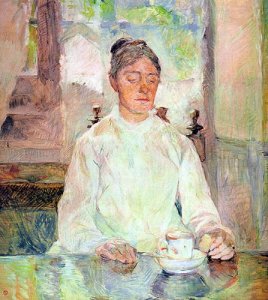
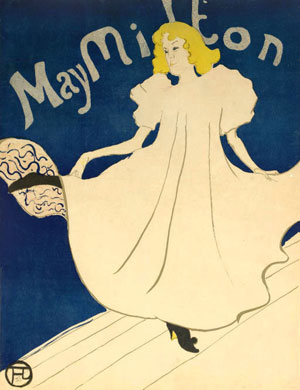 In 1899, his health failing from the effects of alcoholism and syphilis, he was institutionalized for several months at an asylum near Paris. When his health declined again, he returned home to Chateau de Malromé, where his mother owned a vineyard. In 1901 he suffered a stroke. As he lay dying, his mother and a few friends sat at his side. When his father, the rarely-seen Count Alphonse showed up, everyone was astonished, except Henri. He said, "Good Papa. I knew you wouldn't miss the kill."
In 1899, his health failing from the effects of alcoholism and syphilis, he was institutionalized for several months at an asylum near Paris. When his health declined again, he returned home to Chateau de Malromé, where his mother owned a vineyard. In 1901 he suffered a stroke. As he lay dying, his mother and a few friends sat at his side. When his father, the rarely-seen Count Alphonse showed up, everyone was astonished, except Henri. He said, "Good Papa. I knew you wouldn't miss the kill."
On the 20th August, 1901, Lautrec died at the age of 36 at his mother's estate, the Château de Malromé alcoholism and syphilis. The impressionist painting on the left was painted of his mother. His death occured just two months short of his 37th birthday, after almost two decades of depicting Montmartre. His funeral was held in Saint-André-du-Bois and he was buried in Verdelais, Gironde, a few miles from his birthplace. His grave site is near the Calvary hill, in the cemetery at Verdelais, about 2Km from the Chateau. After Toulouse-Lautrec's death, his mother, the Comtesse Adele Toulouse-Lautrec, and Maurice Joyant, his art dealer, promoted his art. As an artist he was incredibly productive, contributing -more than 1,000 paintings, 5,000 drawings, and 350 prints and posters. His mother also provided funds, for a museum to be built in Albi, his birthplace, to house his works. As of 2005, his paintings had sold for as much as US$14.5 million.
Breakthrough Intl - Tom & Alana Campbell 5214 South 2nd Avenue, Everett, Washington 98203-4113 Telephone (425) 391 8487
